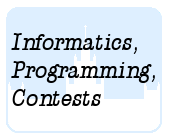Подразделы
Другие разделы
| Тренировка 2 |
| Тренировка 3 |
| Тренировка 4 |
| Тренировка 5 |
Дата и время
04/01/2026 05:26:34
 Тренировка 1
Тренировка 1
b. Catch the Bus! c. Calendar of Events e. Roman Expressions g. Geometric Shapes i. Corporate Identity m. Money Money Money, Must Be Funny r. Railway Transportation s. Soccer Tournament t. Hypertheseus
 r. Railway Transportation
r. Railway Transportation
 Олимпиадные задачи на английском языке
Олимпиадные задачи на английском языке
| 04/02/2008 | Тренировка (задачи CTU Open Contest 2007) (r) |
| 04/02/2008 | Зима 2008 дорешивание (1r) |
Ограничения: время – 3s/6s, память – 64MiB Ввод: input.txt или стандартный ввод Вывод: output.txt или стандартный вывод 
Послать решение Blockly Посылки Темы Где Обсудить (0)
ACM has created a new series of huge billboards. Now, they have to be transported using a train.
Unfortunately, the carriages of the train get somehow mixed, but ACM wants the billboards to
be delivered in an appropriate order.

In a small example, we have 5 carriages approaching a railroad station with 3 parallel tracks.
Each carriage may enter any track, but once it is there, it cannot go back anymore. At the other
end, the tracks are merged back to a single railroad and cannot go back, again. We want the
carriages to leave their tracks in the correct order.
Possible solution is illustrated in the second figure. We may send carriage 4 to the first track,
then the carriage number 2 to the second one, number 5 to the first, number 3 to the second,
and finally, number 1 to the third track, which may immediately leave it to its correct position.
The other carriages will follow as needed.

Your task is to write a program that sends carriages to correct tracks and merges them at the
other end. You may assume that the tracks are long enough to hold any number of carriages.
Input Specification
The input consists of several scenarios, each of them described on two lines. End of the input is
signalized by two zeros.
The first line of each scenario contains two positive integers `N` and `M`, separated with a space,
`N\ ≤\ 200\ 000`, `M\ ≤\ 200\ 000`. `N` is the number of carriages, `M` is the number of tracks.
The second line will contain `N` non-negative integers representing carriages and their intended
order on the other end of the station. Some carriages may have identical numbers, in such a case,
their mutual order is not significant.
Output Specification
For each scenario, output two lines. The first line will contain `N` numbers, each of them between
1and `M` inclusive. Each number corresponds to one carriage (in the order they were given in
the input) and determines a track the carriage is to be moved to. The second line also contains
`N` numbers, they specify from what tracks and in which order are the carriages sent to the other
end of the station.
If carriages are manipulated according to your answer, they must leave the station in a non-descending order. When there are more solutions, you may print any of them. If there is no
solution, print only one line containing the words "Transportation failed".
Sample Input
5 3 4 2 5 3 1 5 3 5 4 3 2 1 0 0
Sample Output
1 2 1 2 3 3 2 2 1 1 Transportation failed

 Начало
Начало